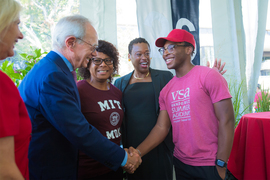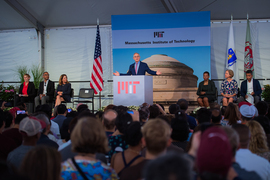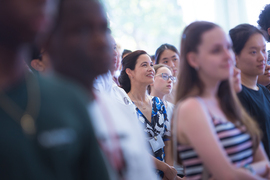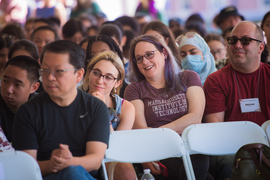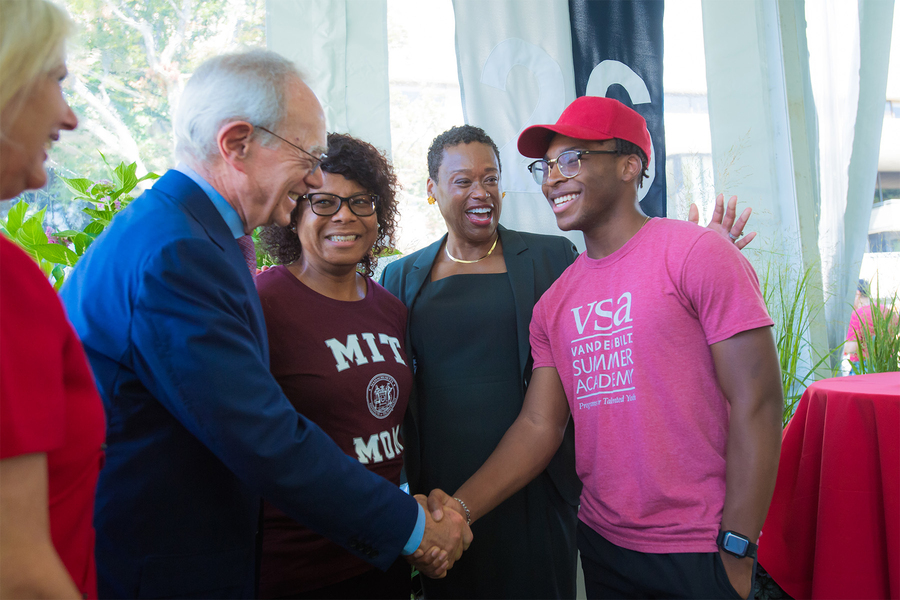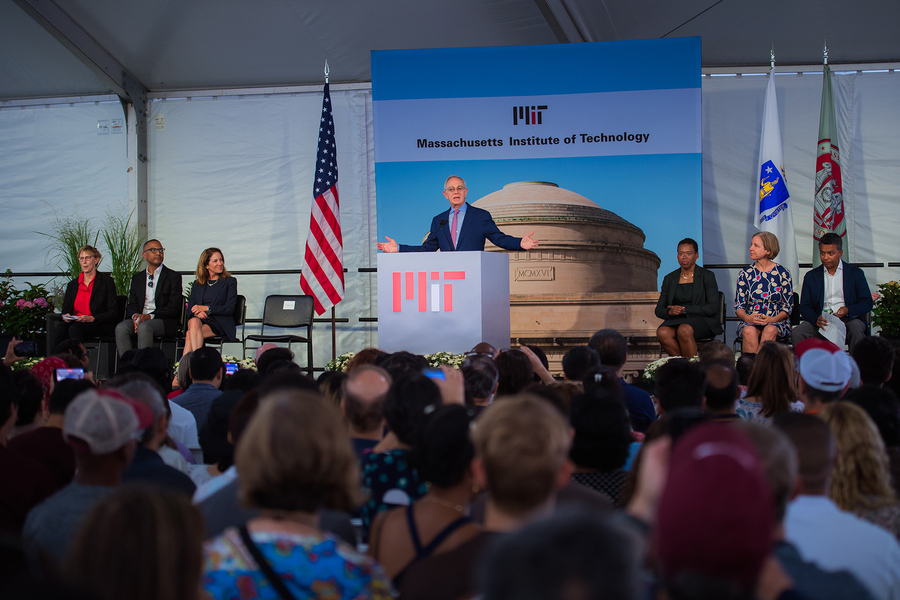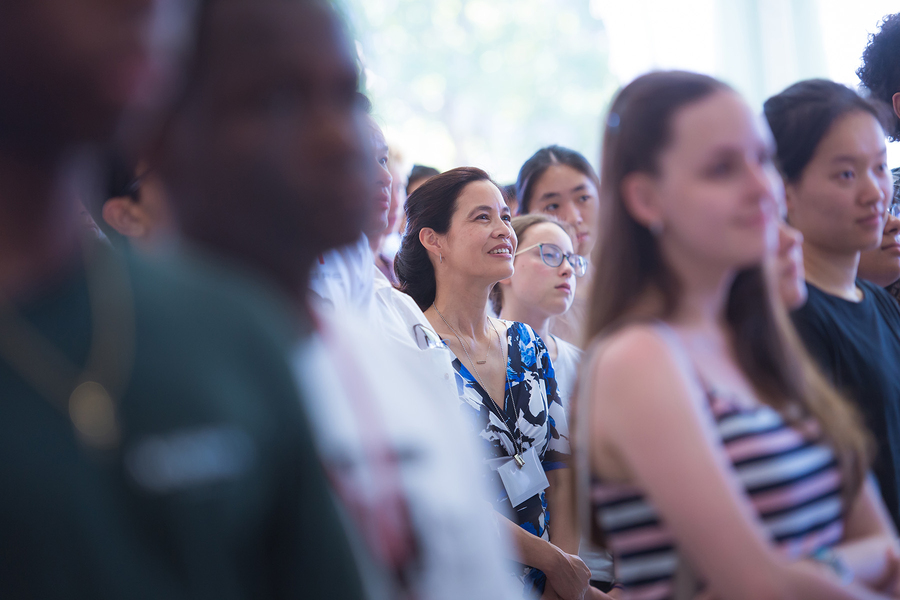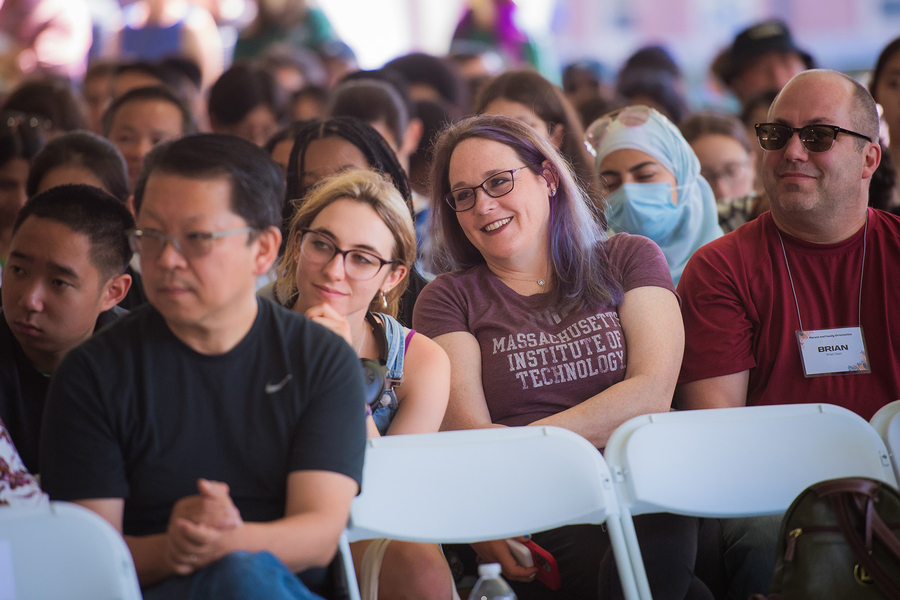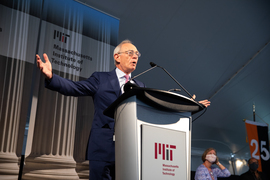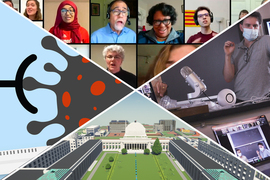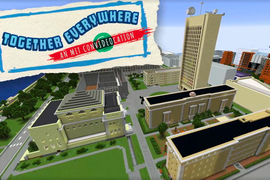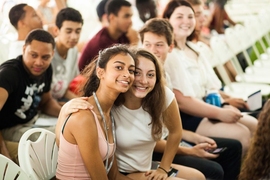On Monday morning, a bright sun and blue sky accented a warm greeting by President L. Rafael Reif to the newest members of MIT — the Class of 2026 — who gathered with their families under a large and airy tent on Kresge Oval for Convocation, the Institute’s annual welcome to the incoming class.
This year’s first-years at MIT comprise 1,139 students, who have come from 50 states, 65 countries, and more than 900 high schools. The incoming class was selected out of a total of 33,796 applicants — a record high that is also 2 percent higher than the number of students who applied to MIT the previous year. The Class of 2026 is also notable in that it will be the last one Reif addresses at Convocation, as he will step down as president at the end of this year.
“This event is one of the gatherings that I will miss most,” said Reif, who welcomed first-years with a story of his own first year at MIT, when he was an assistant professor of electrical engineering and computer science in 1980. The native of Caracas, Venezuela, arrived on the Cambridge, Massachusetts, campus, painfully aware of his accent, unaccustomed to the cold New England winters, and anxious about whether he “had what it took to succeed.”
Those anxieties quickly ebbed, as Reif discovered a community of students, faculty, and staff “who were a lot like me — they loved to ask questions, they were intense, passionate, they loved to tinker, many of them came from somewhere else, and they cared about helping each other and helping society. That was the MIT I found when I arrived, and I am proud to say this is still the MIT I know today.”
To the first-years finding their way at MIT, Reif acknowledged that the experience can be overwhelming and filled with moments of equal parts success and doubt. He urged students to see the latter as a sign of growth.
“Very often those doubts come up when you are trying something new, or pushing yourself, or watching others with more experience,” Reif said. “Please remember: If you have doubts about yourself, it’s just a sign that you are learning.”
Above all, he assured the incoming class: “You are here because you belong here.”
“We believe in you”
As he closed his remarks, Reif briefly introduced incoming students to three members of MIT’s senior academic leadership who are focused on helping students grow and thrive: Provost Cynthia Barnhart, Chancellor Melissa Nobles, and Vice Chancellor and Dean for Student Life Suzy Nelson. He encouraged students to reach out to these leaders and their offices, as well as to friends, faculty, and others in the MIT community for support.
“All of us are dedicated to your success, and we believe in you,” Reif said. “If you need help, please ask. Everybody, and I mean everybody, needs help sometimes.”
For firsthand perspectives on life and work at MIT, Reif turned to three members of the MIT faculty who also are graduates of the Institute: Deb Roy SM ’95, PhD ’99, professor of media arts and sciences and director of the Center for Constructive Communication; Laura Kiessling ’83, the Novartis Professor of Chemistry; and Bryan Bryson ’07, PD ’13, PhD ’13, associate professor of biological engineering. Each faculty member took the incoming class through their own MIT experience.
A noble purpose
For his part, Roy advised first-years to “stay true to your inner child and the passions that brought you here.”
As a kid himself, Roy remembers having always been drawn to “the magical world of electricity and electronics, and eventually computers,” particularly after one frustrating week of failed experiments when he was finally able to make his “home-brewed electromagnetic buzzer finally jolt to life” — a moment that made his mother jump first with alarm, then joy at his success.
“Years later, when I joined MIT as a graduate student in the Media Lab, I found a home for my inner child,” Roy recalled. “I discovered across MIT, a place full of brilliant, playful people who shared my sense of wonder of how the world works, and also a desire to imagine how the world can be improved and made a better place.”
He encouraged students to reach out to others, particularly those who share a common passion. He also urged them to connect their passion to a “noble purpose” — a goal that Roy himself has worked toward in recent years. His research in artificial intelligence and machine learning has contributed to the development of global social media platforms in use today.
“Over the years I started to worry about some of the harms of social media,” he said. “This led me to become convinced that we need to fundamentally rethink how we communicate, and the role technology plays, for the sake of our democracy.”
His research group is now developing communications systems that are designed “for listening and bridging divides.”
“I can’t help but express how important each one of you will be to our future,” Roy said. “Our world is being challenged in fundamental ways: our climate, democracies, economic injustices, our understanding of others, all urgently need attention, energy, and fresh thinking.”
“Let yourself fail”
For Laura Kiessling, who attended MIT as an undergraduate, this week’s Convocation brought her back to her own first-year orientation. Though she doesn’t recall much of what was said, she remembers the feeling all too well — a worry of whether MIT made the right choice in choosing her.
“Yes, I had a solid case of imposter syndrome,” she said to an appreciative rumble from the crowd.
“Many of us experience imposter syndrome, and it takes different forms,” she went on, noting that some may express this stress by silently agonizing, while others “will just sign up for a million of the most advanced classes that they can. Neither of these is the best way to proceed.”
Instead, she suggested that students dive into a few new and different areas to stimulate their creativity beyond the “classical” achievements of p-sets and exams. Taking on a UROP (Undergraduate Research Opportunity Program), where a student can join and contribute to an active research lab on campus, is one way Kiessling recommended to stretch a student’s experience and perspective.
She also urged students to “go ahead and let yourself fail — that’s how we grow.” Kiessling lived this piece of advice firsthand when, as a student taking an advanced chemistry course at MIT, she happened to miss two classes in a row — one when the professor announced there would be an exam, and the next, when the exam was actually given.
“I begged the T.A. to take the exam … and I failed it,” she said. She would have dropped the class, but for the fact that she loved it. So she kept at it, and came away with certain key ideas that eventually fueled her own research today.
Kiessling left first-years with a final bit of advice: “Leave time to bond with MIT people.” She encouraged students to seek out a support network, of other students and also faculty.
“Your professors are people that want to share our love of science, engineering, social sciences, humanities, with you, so don’t leave us out of your equation,” Kiessling said. “Take advantage of our enthusiasm to fuel yours.”
Empowering chance
Bryan Bryson invited first-years to be open to unexpected opportunities and encounters.
“For the next four years, envision this entire campus as your classroom,” Bryson said. “Because I guarantee you that there is almost certainly something for you to learn everywhere you turn at MIT.”
Bryson learned this lesson quite literally as an undergraduate, some 19 years ago. He recalled one day being lost in an MIT hallway when a poster caught his eye. When a professor passing by offered to chat with him more about the poster’s subject, he panicked — intimidated and anxious that he didn’t know enough to ask the right questions. But the conversation started on surprisingly even ground, with a common birthplace (the South), shared hobbies, and eventually, research and the poster’s topic.
That chance encounter was empowering for Bryson, and he wound up working in the professor’s lab for the next three years.
“I always look back at that experience as what one of my friends from orientation, Jackie, calls a serendipitous fulcrum in our MIT experience,” he said.
Today, Bryson makes a special effort as a professor to be open and approachable to his students. He does so in his classroom, and in the residence hall where he is an associate head of house.
“In Simmons Hall, where I live, I tell my students my official title is ‘neighbor,’ so feel free to come by and eat some homemade ice cream, or meet our indoor collection of citrus plants,” he said.
Bryson believes that feeling empowered to make new connections and seeing the humanity in others are essential to MIT’s mission of making a better world.
“What connects us, as students, faculty, and staff alike, is the human desire to solve problems both big and small, for each other and the world around us,” Bryson said.
“The magic of MIT is all of you. And it is deeply connected to your humanity.”
In closing, Bryson encouraged the Class of 2026:
“It is my great wish for you that you experience your own moments of serendipity, as you never know where these hallways at MIT can take you,” he said. “So welcome to MIT, and welcome home.”
